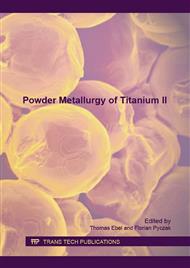p.343
p.351
p.360
p.369
p.378
p.388
p.400
p.406
p.413
Shaping Strategies for Porous Ti Fabrication throughout Colloidal Chemistry
Abstract:
Aimed by reducing the total cost of products, powder metallurgy (PM) processing of Ti is a subject of high interest. However, using of conventional PM techniques presents difficulties due to the intrinsic characteristics of Ti, like low strain ability, and high reactivity, which lead to low compressibility. Moreover, Ti powders with small particle size are difficult to process by conventional PM techniques as they present a lower compressibility and also a poor flowability. On the other hand, the colloidal processing has been used for long in ceramics to achieve green bodies with high densities, complex shapes and homogeneous microstructures, but they are rarely used to shape metal powders because of its high density and high surface reactivity. However, the possibility to process fine particles makes these techniques interesting for metals with low density like Ti.The colloid-chemistry control of metallic powders in aqueous slurries is proposed as a way to prepare Ti porous parts with small particle size, throughout the formulation of aqueous slurries with solid contents as high as 50 vol.%. The chemical and chemical-physic stability of Ti powders 10 μm in size was determined by measuring the zeta potential as a function of pH, and dispersant concentration, while the later optimization of Ti slurries and their adequation for the use of different colloidal techniques, were studied in terms of rheology and the addition of the processing additives, such as gel or foaming agents. Techniques such as thermal gelling, foaming, and impregnation of exo-templates or robocasting were used to build Ti parts with random and/or tailored macroporosity. The shaped pieces made on Ti were sintered in vacuum at 1100 oC for 30 minutes, and their microstructure and mechanical properties were determined and compared with dense materials shaped by combining PM and colloidal techniques in previous works
Info:
Periodical:
Pages:
406-412
Citation:
Online since:
August 2016
Keywords:
Price:
Сopyright:
© 2016 Trans Tech Publications Ltd. All Rights Reserved
Share:
Citation:


